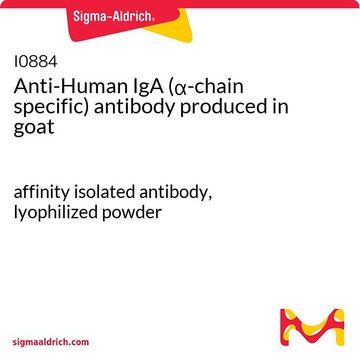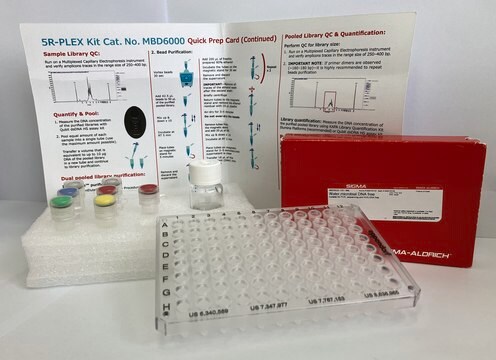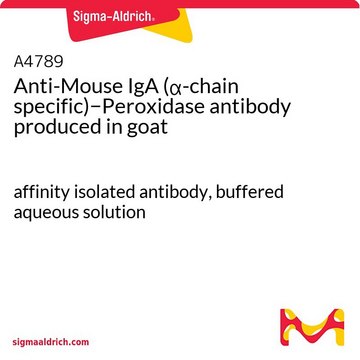AP128F
Goat Anti-Mouse IgM Antibody, µ chain, FITC conjugate
2 mg/mL, Chemicon®
Sign Into View Organizational & Contract Pricing
All Photos(1)
About This Item
UNSPSC Code:
12352203
eCl@ss:
32160702
NACRES:
NA.46
Recommended Products
biological source
goat
Quality Level
conjugate
FITC conjugate
antibody form
F(ab′)2 fragment of affinity isolated antibody
antibody product type
secondary antibodies
clone
polyclonal
species reactivity
mouse
manufacturer/tradename
Chemicon®
concentration
2 mg/mL
technique(s)
immunofluorescence: suitable
shipped in
wet ice
target post-translational modification
unmodified
Specificity
Based on immunoelectrophoresis, the antibody reacts with the heavy chain portion of IgM. No reactivity with IgG or non-immunoglobulin serum proteins was detected, but cross reactivity with IgM from other species may be detected.
F/P RATIO:
9.0 mg/mg; 3.4 moles FITC per mole IgG
F/P RATIO:
9.0 mg/mg; 3.4 moles FITC per mole IgG
Application
Goat anti-Mouse IgM Antibody, μ chain, FITC conjugate detects level of Mouse IgM & has been published & validated for use in IF.
Research Category
Secondary & Control Antibodies
Secondary & Control Antibodies
Research Sub Category
Fragment Specific Secondary Antibodies
Fragment Specific Secondary Antibodies
Physical form
Freeze dried powder. Leyofilized from liquid containing 0.01M sodium phosphate, pH7.6, 0.25M sodium chloride, 15 mg/mL bovine serum albumin, and 0.05% sodium azide.
RECONSTITUTION:
Reconstitute in 1mL deionized water.
RECONSTITUTION:
Reconstitute in 1mL deionized water.
ImmunoAffinity Purified
Storage and Stability
Maintain lyophilized product at 2-8°C for up to 12 months. After reconstitution the product is stable for several weeks at 2-8°C as an undiluted liquid. For extended storage after reconstitution, add an equal volume of glycerol to make a final concentration of 50% glycerol followed by storage at -20°C in undiluted aliquots for up to 12 months. Please note the concentration of protein (and buffer salts) will decrease to one-half of the original after the addition of glycerol. Avoid repeated freeze/thaw cycles.
Legal Information
CHEMICON is a registered trademark of Merck KGaA, Darmstadt, Germany
Disclaimer
Unless otherwise stated in our catalog or other company documentation accompanying the product(s), our products are intended for research use only and are not to be used for any other purpose, which includes but is not limited to, unauthorized commercial uses, in vitro diagnostic uses, ex vivo or in vivo therapeutic uses or any type of consumption or application to humans or animals.
Not finding the right product?
Try our Product Selector Tool.
Hazard Statements
Precautionary Statements
Hazard Classifications
Aquatic Chronic 3
Storage Class Code
11 - Combustible Solids
WGK
WGK 3
Certificates of Analysis (COA)
Search for Certificates of Analysis (COA) by entering the products Lot/Batch Number. Lot and Batch Numbers can be found on a product’s label following the words ‘Lot’ or ‘Batch’.
Already Own This Product?
Find documentation for the products that you have recently purchased in the Document Library.
Importance of the liposomal cationic lipid content and type in tumor vascular targeting: physicochemical characterization and in vitro studies using human primary and transformed endothelial cells.
Sudhir Dabbas,Ritu R Kaushik,Suman Dandamudi,Geoffrey M Kuesters,Robert B Campbell
Endothelium : Journal of Endothelial Cell Research null
Ying Peng et al.
OncoTargets and therapy, 13, 8677-8689 (2020-09-29)
Thomsen-Friedenreich antibody (TF-Ab) is a specific antibody against the Thomsen-Friedenreich antigen (TF-Ag). At present, studies on a number of other tumors have shown that TF-Ab can effectively inhibit metastasis and induce apoptosis in tumor cells. However, the role of TF-Ab
Jamie L Marshall et al.
Human molecular genetics, 21(20), 4378-4393 (2012-07-17)
Sarcospan (SSPN) is a core component of the major adhesion complexes in skeletal muscle, the dystrophin- and utrophin (Utr)-glycoprotein complexes (DGC and UGC). We performed a rigorous analysis of SSPN-null mice and discovered that loss of SSPN decreased DGC and
Wupu Osimanjiang et al.
Journal of neurotrauma, 37(18), 1954-1962 (2020-04-23)
Glycosylation is a fundamental cellular process that has a dramatic impact on the functionality of glycoconjugates such as proteins or lipids and mediates many different biological interactions including cell migration, cellular signaling, and synaptic interactions in the nervous system. In
Our team of scientists has experience in all areas of research including Life Science, Material Science, Chemical Synthesis, Chromatography, Analytical and many others.
Contact Technical Service








